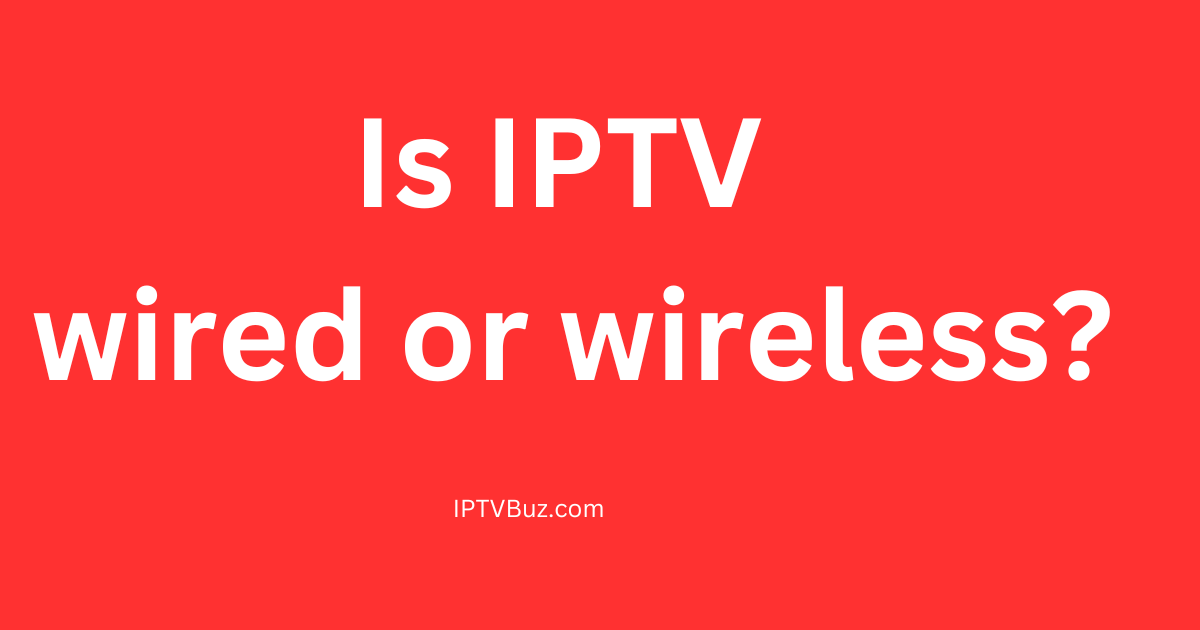IPTV can be delivered through both wired and wireless connections. The choice between wired and wireless depends on the specific implementation and the preferences of the user or service provider.
The users can either use wired or wireless connections for service. Using one of them or both always depends on their choice. Some people have wired connections, while some like to use wireless connections.
Both connections are used for IPTV providers. Let’s have a look at both of them.
Wired IPTV
Ethernet Cable (LAN)
Many IPTV setups use wired connections through Ethernet cables (LAN) to connect the service to a set-top box or smart TV to the internet. This provides a stable and reliable connection with high data transfer rates, making it suitable for streaming high-quality video content.
Wired service typically involves a physical cable to establish a network connection between the IPTV device (such as a set-top box or smart TV) and the internet. The most common type of wired connection for service is through Ethernet cables (LAN).
Here are the key components and details of a wired IPTV setup:
Cabling Infrastructure
In a wired connection setup, an Ethernet cable is used to connect the IPTV device to the local network. This cable is plugged into the Ethernet port on the set-top box or smart TV.
High Data Transfer Rates
Ethernet cables provide high data transfer rates, which is crucial for streaming high-definition video content without buffering or lag. Common Ethernet standards include Cat5e, Cat6, and Cat6a, each supporting different data transfer speeds.
Reliability
Wired connections are generally more reliable than wireless connections. They are less susceptible to interference and provide a stable and consistent network connection, which is important for a smooth IPTV streaming experience.
Router or Modem
Connection to the Internet
The Ethernet cable from the IPTV device is connected to a router or modem, which, in turn, connects to the internet. The router or modem manages the data traffic between the setup box device and the internet.
Quality of Service (QoS)
Some routers may support Quality of Service (QoS) settings, allowing users to prioritize the traffic over other data on the network. This can help ensure a seamless viewing experience by giving priority to the service provider data packets.
Internet Service Provider (ISP)
Subscription to IPTV Service
To access the content, users typically subscribe to a service through their internet service provider. The IPTV service delivers television content over the internet, and the wired connection ensures a reliable and high-speed data transfer.
IPTV Set-Top Box or Smart TV
Interface and Decoding
The IPTV set-top box or smart TV is the device that interfaces with the television and decodes the incoming content streams. It may have a user interface for navigating channels, programs, and on-demand content.
Wired Connectivity
These devices are equipped with Ethernet ports to facilitate a wired connection. Users can connect the device to the internet using an Ethernet cable.
Wireless IPTV
Wi-Fi
IPTV can also be delivered wirelessly using Wi-Fi connections. This allows for greater flexibility in device placement since there are no physical cables involved. However, the quality of the wireless connection may vary depending on factors such as signal strength, interference, and network congestion.
Here are the key components and details of a wireless IPTV setup:
Wireless Router
In a wireless setup, a wireless router is used to establish a Wi-Fi network within the home. The router is connected to the internet, and it broadcasts a Wi-Fi signal that devices, including IPTV devices, can use.
Wi-Fi Standards
Wi-Fi standards, such as 802.11n, 802.11ac, and 802.11ax (Wi-Fi 6), determine the speed and range of the wireless connection. Newer standards generally offer better performance, including higher data transfer rates and improved stability.
Frequency Bands
Wi-Fi operates on different frequency bands (2.4 GHz and 5 GHz). The 5 GHz band is generally less crowded and can provide faster and more reliable connections, especially in environments with many Wi-Fi devices.
IPTV Device with Wi-Fi Capability
Smart TVs or Set-Top Boxes
Wireless IPTV is commonly used with smart TVs that have built-in Wi-Fi capabilities. Alternatively, users can use set-top boxes that support wireless connectivity.
Connection to Wi-Fi Network
Users need to connect their IPTV device to the wireless network by entering the Wi-Fi network credentials (SSID and password). This allows the device to communicate with the wireless router and access the internet.
Internet Service Provider (ISP)
Subscription to IPTV Service
Just like in wired setups, users subscribe to an IPTV service through their internet service provider. This service delivers television content over the internet, and the wireless connection provides the necessary connectivity.
Internet Speed Requirements
A sufficient internet speed is crucial for smooth streaming. Higher-quality video content may require faster internet speeds to ensure a buffer-free viewing experience.
Quality of Service (QoS)
Router Settings
Some routers may have Quality of Service (QoS) settings that allow users to prioritize IPTV traffic over other internet traffic on the network. This can help prevent interruptions and ensure a better viewing experience.
Wireless Interference Considerations
Interference Factors
Wireless connections can be susceptible to interference from other electronic devices, walls, and other obstacles. Signal strength and stability may be affected by factors like the distance between the router and the IPTV device.
Mesh Wi-Fi Systems
In larger homes or areas with wireless dead spots, users may opt for mesh Wi-Fi systems to improve coverage and stability.
I specialize in crafting words that persuade, engage, and make things happen. From catchy headlines to irresistible calls to action, I use the magic of words to connect with your audience and drive results. I am well Versed Equipped with 5 years specializing in IPTV and entertainment content, I’m driven by a passion for weaving captivating narratives and delivering insightful content within the ever-evolving era of media.

